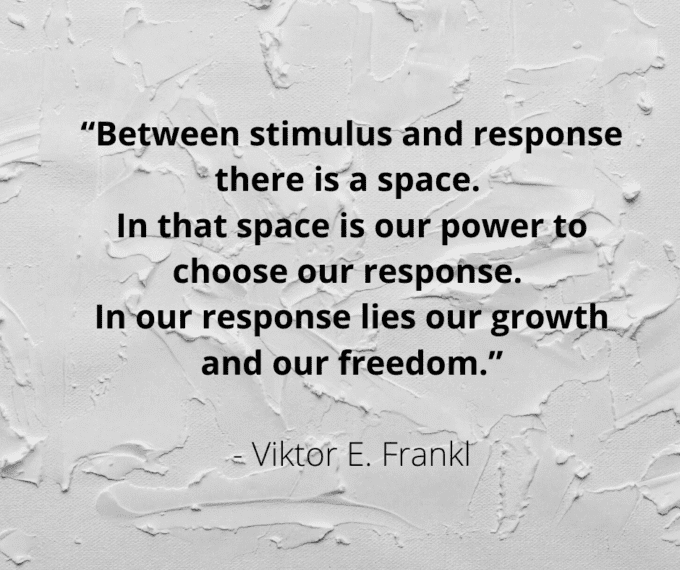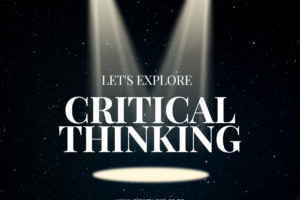What is critical thinking? When we hear the phrase ‘critical thinking’ we tend to assume…

Emotional Agility
Emotional agility is simply our ability to recognise our thoughts, our emotions, and our behavioural patterns, in the moment, so that we can choose how we wish to respond, rather than simply reacting.
Our ability to catch ourselves in the moment allows us time to create a space and it’s in that space that we can decide how we would like to respond to any given situation – effectively creating a separation between what is happening around us and how we respond to it (what is happening to us).
When we have emotional agility we maintain a greater ability to cope with the complexities and challenges of today’s world while still remaining engaged and productive.
When we are emotionally agile, we have the ability to respond in a way that aligns with our personal values and in our best interest.
Emotional agility is based in choice
Viktor E. Frankl, a neurologist, psychologist, and Holocaust survivor says, “Between stimulus and response there is a space. In that space is our power to choose our response. In our response lies our growth and our freedom.”
How do we become more emotionally agile?
Recognise your patterns
The first step in developing emotional agility is to notice your own personal patterns. Patterns in themselves can be complex and difficult to identify at first but it does get easier the more you practice.
Perhaps you find yourself frustrated, angry, hurt is repeating situations?
Maybe there are scenarios where you regularly lack confidence?
Do you have a consistent belief about something or someone?
Are you paying too much attention to your internal chatter, using too much energy?
Is there a person that regularly winds you up?
These are situation when you’ve been hooked by your thoughts and feelings – when you find yourself responding from a reactionary state, a state which uses an important cognitive resource (brain energy) and emotional energy; A state that doesn’t always serve you.
Label your thoughts and emotions
When you’re hooked, the attention you give your thoughts and feelings crowds your mind; leaving no room to examine them for validity. You are no longer agile.
One strategy that may help you consider your situation more objectively is the simple act of labeling. Just as you would call a pen a pen, try calling a thought a thought and an emotion an emotion. For example, your internal chatter might say “I’m not doing enough at work or at home” using this statement to keep you hooked in your negative thought pattern. Instead, try saying “I’m having the thought that I’m not doing enough at work or at home”. Similarly, the internal thought “My boss is so arrogant, he makes me so angry” could become “I’m having the thought that my boss is so arrogant, and I’m feeling anger”. Labeling allows you to see your thoughts and feelings for what they are: transient sources of data that may or may not be valid or helpful.
In labeling what you are thinking and feeling you become able to take a more helicopter view of private experiences. This is an aspect of Mindfulness; of noticing. There is mounting scientific evidence shows that simple, straightforward mindfulness practice like this not only improves behaviour and well-being but also promotes beneficial biological changes in the brain and at the cellular level. As you start to slow down and label her thoughts, you are able to observe them and your patterns and reflect objectively on whether that information is true. I often call this evidence gathering. The criticisms that had once pressed in on you, consuming your thoughts, behaviour, and energy become more like clouds moving through a blue sky. You are able to observe them, label them, and then let them go.
Accept them (the letting go part)
The opposite of control is acceptance. Rather than acting on every thought try simply noticing that they exist. You may even be able to observe these thoughts and feelings like you were watching it play out in a movie. Once you have been doing this for a while and you have started to identify patterns, you could even laugh at the predictability of them. But be warned, this is not always a “peace and rainbows” solution. While this can bring relief and provide the essential space to observe and choose, it won’t necessarily invalidate the feeling. In fact, you may realise just how upset you really are. When viewed in an observational manner, with curiosity and compassion (for yourself and others), this approach may help you examine the reality of the situation more objectively.
What’s going on—both internally and externally?
You may begin to notice that the feeling of frustration or anger is a signal that something important is at stake for you – a values breach – and that you need to take productive action. By allowing a place for curiosity and compassion, your emotional response may highlight and inform your actions rather than undermine them. Instead of yelling at people, you could choose an intentional focus that allows you to make clear requests of others, to detail more ideal outcomes, and propose some defined timelines.
Act on your values
When you separate yourself from your difficult thoughts and emotions, you expand your choices. You can decide to act in a way that aligns with your values and who you want to be, both personally and professionally. When aligned with your values you can quickly assess if your response is going to serve you and your values in the long term as well as the short term.
This framework will help steer you in a direction that you want to go, allowing you to ask yourself in each moment if you are taking a step toward who you most want to be, and living the life you most want to live.
The mind’s thought is endlessly, and emotions change like the weather, but values can be called on at any time, in any situation. Your own personal values are the one true measure of whether you are living the life that you want to live, being the person that you want to be – the measure of a rich and fulfilling life.



